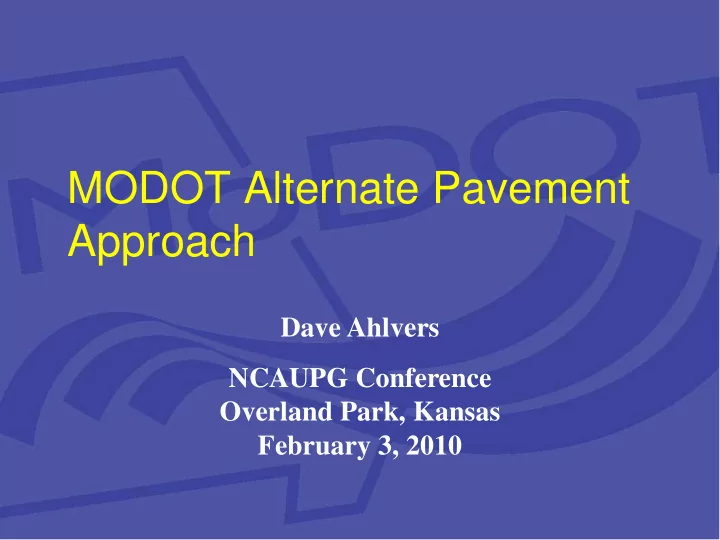

MODOT Alternate Pavement Approach Dave Ahlvers NCAUPG Conference Overland Park, Kansas February 3, 2010
Cost Control in Missouri implementation - the road to success • Past Decade – Letting schedules optimized • Spring 2002 – Performance Spec.s written • Fall 2003 – Alternate bidding pavements required • December 2004 – Practical Design concept pitched to Commission • Spring 2005 – Districts challenged to cut STIP 10% • Fall 2005 – First Practical Design Policy written • 2006 – First Design/Build Projects • Fall 2007 – First ATC Project
Alternate Pavement Bidding Responsibility 5,000 miles of Major Roads 27,000 miles of Minor Roads 10,000 Bridges
Annual Pavement Quantities Year Asphalt Concrete Tons $$ YD 3 $$ 1992 4,950,706 106,542,443 599,575 30,760,634 1995 2,110,902 50,445,371 744,506 63,910,232 2000 5,115,218 200,192,172 1,141,790 108,794,341 2005 8,035,462 397,618,849 604,216 78,585,445 2006 2,467,655 134,679,642 573,052 77,422,513 2007 3,745,808 178,237,592 867,917 103,433,907 2008 2,087,204 122,035,246 667,354 90,891,896
First Alternate Bidding Experiment Missouri let five pilot projects in 1996 under the auspices of FHWA SEP-14 Project conditions included Design costs within 15% of each other At least one mile of paving Primary work was paving Minimal grade change impact Area unit prices An LCCA adjustment factor was used
Alternate Bidding Restart Pavement Team; composed of MoDOT, PCC and HMA paving industry, and FHWA representatives; recommended in 2003 to restart alternate pavement design bidding Open, Transparent Process LCCA assumptions difficult to reach consensus on
Alternate Bidding Pavement Design From 1993 – 2004 a simple catalogue design, derived from the 1986 AASHTO Guide for the Design of Pavement Structures, was used for new Jointed Plain Concrete pavements. The Pavement Team recommended adopting a mechanistic-empirical (M-E) design approach for pavements in Missouri .
Alternate Pavement Design Bidding maximizing competition ‘ Structurally Equivalent ’ PCC and HMA bid competitively by using life cycle cost analysis correction factors.
Alternate Pavements - Policy Alternate pavement design with a LCCA factor for projects with 7500 sq yd in a continuous area Optional pavement designs without a LCCA factor for smaller paving quantities New full depth and major rehabilitation
M-E Design Implementation Started using nationally-calibrated MEPDG program at the beginning of 2005 for JPCP and HMA designs. Average JPCP thicknesses reduced by ~ 2” for high truck volume routes ~ 1 ” for low to medium truck volume routes Average HMA thicknesses reduced by ~ 3- 4” for high truck volume routes ~ 1-2 ” for low to medium truck volume routes
Reasons for Selecting NCHRP M-E Pavement Design Guide Common traffic and climatic module platforms are provided for both PCC and HMA analysis Distress models were calibrated and validated with largest pavement database ever New materials in designs could be evaluated Probably will become most defensible method because of AASHTO adoption
Alternate Pavement Designs New construction (based on M-E Design Guide) JPCP Conventional HMA Rehabilitation (default thickness derived partly from M-E and empirical data) 8” Unbonded PCC overlay (UBOL) Rubblization w/ 12 “ HMA overlay
Method of Measurement New JPCP and HMA measured in square yards Unbonded overlays measured in cubic yards for furnishing and square yards for placing HMA overlay (on rubblized PCC) measured in wet tons
Alternate Pavement Bidding seeking innovation Performance specifications Eliminate method specifications where possible.
Alternate Design Life Cycle Costs LCCA used solely to determine adjustment factor for 45-year design life Life cycle costs considered Initial construction Maintenance Rehabilitation Salvage value User costs
Rehabilitation Assumptions HMA Mill and fill wearing course at 20 years in driving lanes Mill and fill wearing course at 33 years across whole surface PCC Diamond grind whole surface and perform full-depth repairs on 1 ½ % of surface area at 25 years
Adjustment Factor Adjustment factor = PW (future HMA rehab) – PW (future PCC rehab)
Adjustment factor calculated by Estimating Section using current market unit prices Present worth (PW) values of future rehabilitation determined using OMB discount rates.
Alternate Bid Selection Low bidder = lower of (PCC bid price) vs. (HMA bid price + adjustment factor)
Alt. Pavement Update for Jobs Thru July 2009 with LCCA Factor 124 Alternate Projects to Date ($1.645 bil) 118 Full Depth ($1.562 bil) 6 Rehabilitation ($82.6 mil) Full Depth 40 Asphalt Awards ($451.7 mil) 78 Concrete Awards ($1.111 bil) Rehabilitation 1 Asphalt Award ($2.6 mil) 5 Concrete Awards ($80 mil)
Results – Difference in Low Bids Low PC Bids vs. Low AC Bids w/o LCCA Factor PC Total – $645,054,399 AC Total - $666,875,468 Difference - $21,821,069 (3.4%) Low PC Bids vs. Low AC Bids w/ LCCA Factor PC Total – $645,054,399 AC Total - $691,278,469 Difference - $46,224,069 (7.2%) LCCA Factor has Determined Low Bid 3 Times since October 2003.
Number of Bidders 6 5.5 4.8 5 4.2 4.2 3.7 4 Bids/Call 3 2 1 0 2005 2006 2007 2008 Alt. Paving Projects Oct 03 to Present
Price Summaries 3-year average asphalt price/ton for alternate paving projects is 5.1% below that for non-alternate projects and 4.8% below the 3-year average for all projects 3-year average concrete price/CY for alternate paving projects is 8.6% below that for non-alternate projects and 2.8% below the 3-year average for all projects
Other Optional Bidding Intermediate overlays 5 ¾” HMA vs. 5” „big block‟ PCC Thinner overlays 3 ¾” HMA vs. 4” ultrathin PCC or 5” „big block‟ PCC
Other Optional Bidding Thin overlays 1 ¾” HMA vs. 1” HIR plus surface treatment and 3 ¾” HMA vs. 4” CIR plus surface treatment
Optional Shoulder Designs A2 design 5 ¾” HMA 5 ¾” PCC A3 design 3 ¾” HMA 4” PCC (also roller compacted concrete pavement option)
An independent third party peer review was performed in late 2005 by a respected national consultant on MoDOT‟s alternate pavement bidding process. “It appears that MoDOT has developed a balanced, innovative program that could serve as a national model for other highway agencies throughout the nation and beyond.”
Thank You! Questions? For more information including example plans and specifications go to: http://epg.modot.mo.gov david.ahlvers@modot.mo.gov (573) 751-7455
Recommend
More recommend